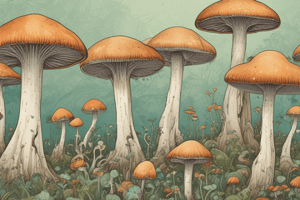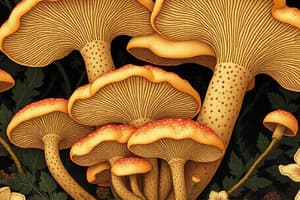Podcast
Questions and Answers
What is the characteristic of fungal cell walls?
What is the characteristic of fungal cell walls?
- Have chlorophyll and contain mannan
- Lack chlorophyll and have cellulose
- Contain chitin, mannan and β-glucans (correct)
- Contain cellulose
Which of the following is a characteristic of microscopic fungi?
Which of the following is a characteristic of microscopic fungi?
- Lack chlorophyll and have cellulose
- Unicellular or multicellular (correct)
- Always filamentous
- Multicellular with several cell types
What is the term for the entangled mass of hyphae?
What is the term for the entangled mass of hyphae?
- Hypha
- Fungus
- Cellulose
- Mycelium (correct)
What is the primary growth form of multicellular fungi?
What is the primary growth form of multicellular fungi?
What is the term for the type of hyphae that are continuous or branching filaments filled with cytoplasm and multiple nuclei?
What is the term for the type of hyphae that are continuous or branching filaments filled with cytoplasm and multiple nuclei?
What is the function of the septa in septate hyphae?
What is the function of the septa in septate hyphae?
Which of the following is NOT a characteristic of fungi?
Which of the following is NOT a characteristic of fungi?
What is the term for the study of fungi?
What is the term for the study of fungi?
Which of the following products benefits from fungal activity?
Which of the following products benefits from fungal activity?
What is the primary source of the antibiotic Penicillin?
What is the primary source of the antibiotic Penicillin?
Which fungus is used to control nematodes in the soil?
Which fungus is used to control nematodes in the soil?
What is the main cause of crop diseases?
What is the main cause of crop diseases?
What is the result of fungal diseases in crops if left untreated?
What is the result of fungal diseases in crops if left untreated?
Which of the following is an example of a human fungal infection?
Which of the following is an example of a human fungal infection?
What is the result of fungal spoilage on food?
What is the result of fungal spoilage on food?
Which of the following is an example of a fungus used in biological control of pests?
Which of the following is an example of a fungus used in biological control of pests?
What is the result of the fusion of haploid nuclei of compatible hyphae?
What is the result of the fusion of haploid nuclei of compatible hyphae?
What is the characteristic feature of the Chytridiomycota group?
What is the characteristic feature of the Chytridiomycota group?
What is the characteristic feature of the Zygomycota group?
What is the characteristic feature of the Zygomycota group?
What is the characteristic feature of the Ascomycota group?
What is the characteristic feature of the Ascomycota group?
What is the characteristic feature of the Basidiomycota group?
What is the characteristic feature of the Basidiomycota group?
What is the common name for Rhizopus and Mucor species?
What is the common name for Rhizopus and Mucor species?
Which group of fungi includes yeasts and food spoilage moulds?
Which group of fungi includes yeasts and food spoilage moulds?
What is the term for the structure in which basidiospores are produced in Basidiomycota?
What is the term for the structure in which basidiospores are produced in Basidiomycota?
What is the main function of vegetative hyphae?
What is the main function of vegetative hyphae?
Which of the following is an example of parasitism?
Which of the following is an example of parasitism?
What is the term for the association between fungi and the roots of higher plants?
What is the term for the association between fungi and the roots of higher plants?
What is the result of continued growth and branching of a hypha?
What is the result of continued growth and branching of a hypha?
Which of the following is a mode of reproduction in fungi?
Which of the following is a mode of reproduction in fungi?
What is the term for the outgrowth that develops from a spore?
What is the term for the outgrowth that develops from a spore?
Where can fungi be found?
Where can fungi be found?
What is the term for aerial hyphae that produce asexual spores?
What is the term for aerial hyphae that produce asexual spores?
What is the location of the basidium in a mushroom?
What is the location of the basidium in a mushroom?
Which of the following is an example of a toadstool?
Which of the following is an example of a toadstool?
What is the primary role of fungi in the ecosystem?
What is the primary role of fungi in the ecosystem?
What is the term for the symbiotic association between fungi and plant roots?
What is the term for the symbiotic association between fungi and plant roots?
What is the role of mycorrhizal fungi in plant growth?
What is the role of mycorrhizal fungi in plant growth?
What is the primary use of fungi in the food industry?
What is the primary use of fungi in the food industry?
What is a characteristic of truffle mushrooms?
What is a characteristic of truffle mushrooms?
What is the economic importance of fungi in agriculture?
What is the economic importance of fungi in agriculture?
Flashcards are hidden until you start studying
Study Notes
Fungal Diversity
- Fungi do not belong to the plant kingdom and were originally classified with photosynthetic plants, but later grouped with algae and protozoa (protista) and eventually placed in the Kingdom Mycota.
- Fungi lack chlorophyll and their cell walls contain chitin, mannan, and β-glucans, which is a characteristic of some animal cells.
- Cellulose is generally absent from the cell walls of true fungi.
Structural Forms
- Fungi can exist as unicellular (single-celled and colonial – yeasts) or multicellular forms with several different cell types.
- Multicellular fungi are primarily filamentous in their growth form, consisting of long, slender filaments (hyphae) that form an entangled mass called mycelium.
Morphological Features of Hyphae
- Hyphae can be classified into two types based on their structure: • Aseptate (coenocytic) hyphae: continuous or branching filaments filled with cytoplasm and multiple nuclei. • Septate hyphae: long chains of cells joined end-to-end and divided by cross-walls (septa) with pores.
Hyphae Classification Based on Function
- Hyphae can be classified into three types based on their function: • Vegetative hyphae: grow as submerged or surface filaments that digest, absorb, and distribute nutrients obtained from the substrate to other parts for growth and development. • Aerial hyphae: project above the surface in culture medium. • Reproductive (fertile) hyphae: produce asexual spores on the surface of the substrate.
Nutrition
- Fungi acquire nutrients by three means: • Parasitism: obtaining nutrients from another living organism. • Saprophytism: absorbing nutrients from dead organic matter. • Symbiotic associations: exchanging nutrients with other organisms, especially roots of higher plants.
Habitat
- Fungi occur in both terrestrial and aquatic environments, including freshwater and marine ecosystems.
Reproduction
- Fungi reproduce in three ways: • Sexual reproduction: forming sexual spores. • Asexual reproduction: forming conidia or asexual spores. • Vegetative reproduction: budding, as seen in yeast.
Life Cycle
- Both sexual and asexual reproduction occur in fungi.
- During asexual life cycle, spores settle on a substrate, develop an outgrowth known as a germ tube, and then elongate into a hypha.
- During sexual life cycle, haploid nuclei of compatible hyphae fuse to form a diploid nucleus, which then participates in sexual spore development through meiosis.
Fungal Classification
- The four major groups of fungi are: • Chytridiomycota: characterized by motile spores (zoospores), commonly called chytrids. • Zygomycota: characterized by the production of non-motile spores, with a coenocytic mycelial organization. • Ascomycota: characterized by the production of sexually produced spores (ascospores) contained within a sac (ascus). • Basidiomycota: characterized by the production of basidiospores in a structure called a basidium.
Economic Importance of Fungi
- Fungi play a crucial role in recycling nutrients and maintaining soil fertility.
- Fungi form symbiotic associations with plant roots, enhancing plant growth and development.
- Fungi are used as food, either directly or indirectly in the food and beverage industry.
- Fungi produce antibiotics used medicinally to control diseases.
- Fungi are used in biocontrol of soil-borne pathogens.
- Fungi can cause crop diseases, animal diseases, and spoilage of food and goods.
Studying That Suits You
Use AI to generate personalized quizzes and flashcards to suit your learning preferences.




